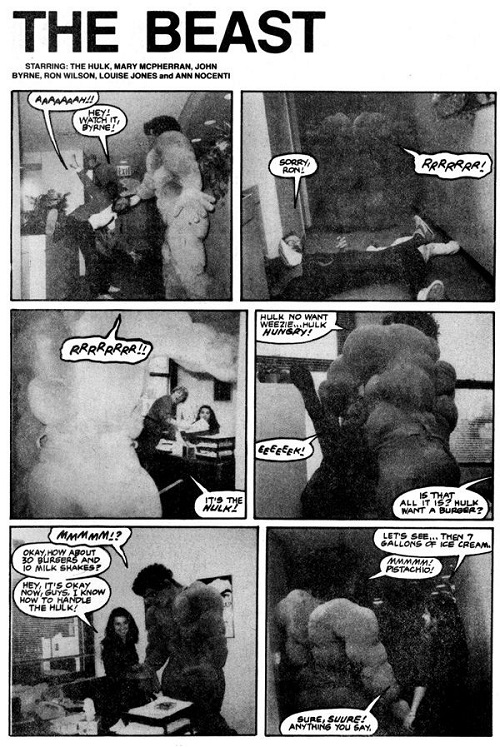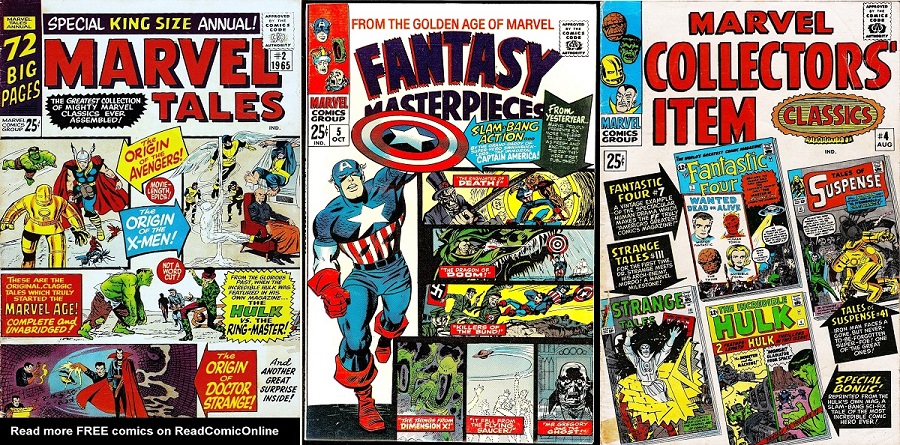In recent months, I’ve often caught myself thinking about the Marvel Special Edition reprint line of the early 1980s, mainly because last summer, one of the regulars at the Classic Comics Forum began, for a time, posting large excerpts of posts from Jim Shooter’s blog, back when the latter was regularly blogging for about two or so years around 2010 and 2011.
As a side note, I should say that was a regular reader of Shooter’s blog posts back then, and when they were re-posted at the CCF, I found them just as engrossing as the first time I read them. Shooter, by the way, left all of those posts and the accompanying comments up, and they are well worth reading if you’re interested in some of the behind the scenes stuff at Marvel back in the late 1970s and the 1980s – i.e., during Shooter’s tenure as assistant editor and then editor-in-chief. Obviously, it’s all from his point of view, so you should probably keep your critical goggles strapped on as you read, but it’s still fascinating stuff. But that’s not what this post is about.
What set my gears into motion, again, was when I re-read something that caught my eye the first time Shooter discussed it in a post from 2011 – and I found myself thinking about it just few days ago, as I was flipping through some comics I have reprinting Jim Steranko’s Nick Fury stories from the late 1960s. Shooter was talking about the machinations going on at the corporate level in Marvel’s parent company, Cadence Management, in the early 1980s. It’s too long to recount everything here (if you’re interested, go read Shooter’s whole post), but to summarize, a few of the corporate overlords needed quick and abundant cash to fight off a hostile takeover bid. So in this context, Shooter claimed that it was up to the comics publishing division to accomplish that task. To wit:
“(…) Remember all the ‘junk publishing’ Marvel did in the early 1980’s? The No-Prize Book? The Fumetti Book? All the reprints? They happened because I was commanded to generate cash — some millions of dollars — any way I could…”
My emphasis on the phrase “junk publishing,” although the scare-quotes are Shooter’s – implying that perhaps this was possibly a phrase being thrown around at the Marvel offices back then. Well, this is the Atomic Junk Shop, so I’m going to take a closer look at some of the stuff Shooter is calling junk.
First, I’ll concede that the first two titles he mentioned, the No-Prize Book and the Fumetti Book, may have indeed been questionable publishing projects.

I suppose I can see some point, just barely, to the No-Prize Book in those pre-internet days, but if the humor in the rest of the Fumetti Book is anything like this knee-slapper sample page I found posted online, I can see why everyone involved would rather it be forgotten:

What I find a bit questionable, though, is that Shooter lumped in “all the reprints” under the ‘junk publishing’ umbrella. First, there’s the obvious point that Marvel had been in the business of publishing reprints since, well, not long after the Marvel Age began back in the 1960s – annuals (and later the giant-size books) often contained reprints, and the various ongoing reprint titles became a regular staple of Marvel’s output by the mid-to-late 1960s.

By the 1970s, Marvel was churning out tons of reprints, which by that time were a fixture of the comics landscape, and it would stay this way well into the 1980s. The various reprint series (Marvel Tales, Marvel’s Greatest Comics, Tales of Suspense, Marvel Triple/Super Action, just to name a few) were a boon to many young comics fan at the time (like me) because that was pretty much the only way to catch up on a ton of stories from the 1960s, early 1970s.

However, Shooter probably wasn’t thinking of any of the long-running reprint titles, but rather the line of ‘Marvel Special Edition’ reprints that began to appear in the early 1980s (and yes, I’m aware that not all of them were actually designated as ‘special editions,’ but they were obviously part of the same line). These were always limited series, or just single issues, that reprinted major and/or well-remembered fan-favorite stories, printed on higher-quality paper than the regular comics, often with nice new – sometimes wraparound – cover art.
And they were friggin’ awesome!
First, there’s the Steranko material I mentioned above, collecting the stories from Nick Fury #s 1-3, 5 (plus a story from Strange Tales #168 – the one about the alien invasion).

Sticking with Steranko, we were also treated to his all-too-brief tenure on Captain America, i.e., issues 110, 111 and 113:

Since these three issues were hardly enough to fill two roughly 50-page books, they contain some nice extra materials: the first one has the story “At the Stroke of Midnight” from Tower of Shadows #1, while the second one has “Dark Moon Rise, Heck Hound Hurt” from Not Brand Echh #11 (a spoof of “Dark Moon Rise, Hell Hound Kill” from Nick Fury #3), the lush romance story “My Heart Broke in Hollywood” from Our Love Story #5, and “Spy School,” a Nick Fury story guest-starring Captain America, from Strange Tales #159.

So much goodness in these two sets of books. They were back then, and still are, a really inexpensive way to get a whole bunch of classic material by Steranko. And that point about expense is a really important consideration for me. A little over 10 years ago I really wanted to finally read the entirety of Starlin’s Warlock saga, but the price of vol. 2 of the Masterworks edition collecting it was (and still is) too high for me. Then I remembered there was a set of special edition reprints from the early 1980s.

These contain everything in that aforementioned Masterworks volume, at a fraction of the cost. And the covers are simply lovely.
If you want to read the first big story arc in Micronauts by Bill Mantlo and Michael Golden, nothing beats this lovely set, since it’s unlikely to ever get collected and reprinted in a trade volume:

As noted, there were a number of single-issue editions as well, including this one featuring Dr. Strange, collecting the Silver Dagger story by Englehart and Brunner from the initial issues of Doc’s solo series, with a new wraparound cover by Berni Wrightson…

…and a Conan book with a reprint of the adaptation of Red Nails, by Thomas and Barry Windsor Smith (in color).

And the examples above are just the ones I currenzly have. Others special editions collected most of the Kree-Skrull war in Avengers (in two issues), the Sentinels arc in X-men, also by Roy Thomas and Neal Adams (in three issues), another X-men book featuring the origin of the all new team from Giant-size X-men #1 plus a new story by Claremont and Cockrum (that was one of the only ones I actually had back then), the early Moon Knight stories from the Hulk magazine by Moench and Sienkiewicz (in three issues) and the story from Fantastic Four Annual #1 (with a new wraparound cover by John Byrne). And I’m sure there’s a few more that I’ve overlooked.
Basically, these functioned a lot like the trade paperback or HC collections that only began to appear in the latter half of the 1980s and are now, of course, a staple of comics publishing.
So for Mr. Shooter this may have been ‘junk’ resulting from some skeevy corporate maneuvers to generate quick cash and bolster the bottom line, but they were and are pure gold to me.


I own the Moon Knight ones, and they are quite nice. I will say that the coloring on the Conan book is godawful. Just really terrible. It’s too bad, too, because the pencils are awesome. Coloring black-and-white doesn’t work for movies, and it rarely works for comics, either!
I don’t hate the coloring as much as you do, but since I also have the Red Nails adaptation in b&w in the first Savage Sword phonebook, I’ll readily acknowledge that it looks better. However, the BWS Red Nails was also reprinted in color in a treasury edition in the mid-1970s (which I used to have) and it looked fine there.
What he likely meant by “junk publishing” was that these reprints were meant to be like junk bonds, produced to generate quick cash for the company, as he implied in the statement.
I totally lucked out a few years ago and picked up The Essential Warlock for a buck at a book sale. I already had the Starlin stuff but it was interesting to read the early Messiah of Counter-Earth arc. And then rereading the Starlin was an absolute joy.
“another X-men book featuring the origin of the all new team from Giant-size X-men #1 plus a new story by Claremont and Cockrum”
I have that one! It was my first copy of Giant-Sized X-Men #1 (I now have the Masterworks edition as well. Also Classic X-Men #1, but that kind of mangles it.)
I like Louis’ interpretation above.
I remember that THE COMICS JOURNAL was really pushing the theory that these titles were designed to take up rack space and soak up fan/retailer dollars in an effort to keep the new breed of independent publishers from gaining traction in the direct sales market. Shooter seems to say there was no long term strategy; it was actually all about making Marvel a lot of money really fast.
“I remember that THE COMICS JOURNAL was really pushing the theory that these (reprint) titles were designed to take up rack space and soak up fan/retailer dollars in an effort to keep the new breed of independent publishers from gaining traction in the direct sales market.”
No, Edo’s made a mistake – all those long standing reprint titles that he claims “went well into the 1980s” were actually all canceled between 1980-82, and were replaced with DAZZLER (the first Marvel Direct Market comic), the Epic Comics Imprint (starting with Jim Starlin’s DREADSTAR), the Marvel Graphic Novels Imprint (starting with DEATH OF CAPTAIN MARVEL, THE NEW MUTANTS and X-MEN GOD LOVES MAN KILLS), and the launch of GI JOE, all in 1981-82. These “Special Edition” mags were quick ‘junk bond’ comics, while Shooter, Goodwin, Gruenwald, DeFalco and Kalish were trying to build the company while Galton and his cronies were taking all the profits out of the publishing arm to feed into Galton’s interests.
What TCJ was bitching about is the launch of Epic which ‘stole creator owned concepts from the indies and brought them to the corporate control’, and then the subsequent launches of the STAR COMICS imprint in 1984 (which featured about 35 released titles over the four years it existed) and the eight title New Universe imprint in 1986.
Like Edo, I had an issue of Marvel Tales as one of my first comics as well, except it was early ’90s and reprint the first Hobgoblin. Very cool to have been able to jump into comics collecting with both the kewl new stuff on the stands (the last stuff the Image dudes did before jumping ship, basically) and somewhat older stuff, all on the same spinner rack!
Travis: “I had an issue of Marvel Tales as one of my first comics as well, except it was early ’90s and reprint the first Hobgoblin.”
That would be Marvel Tales #257, released in November of 1991 (January 1992 cover date). Marvel Tales was the only ongoing reprint book to survive the culling in 1981-82.